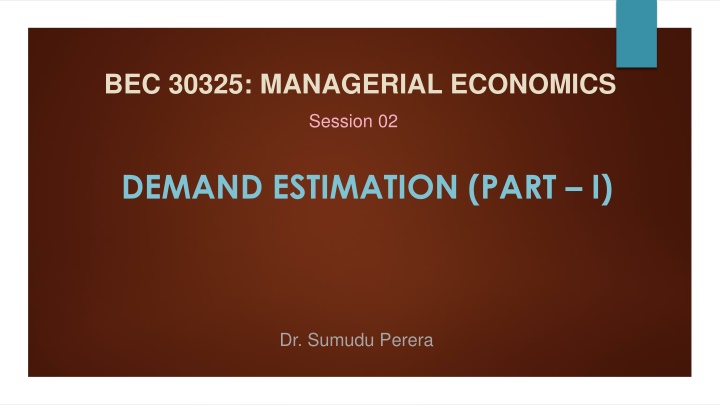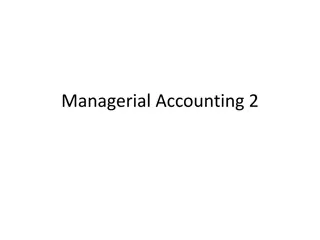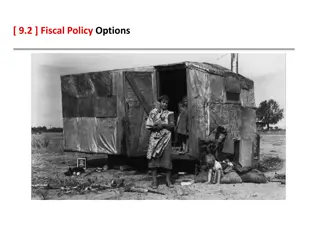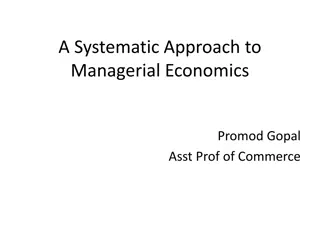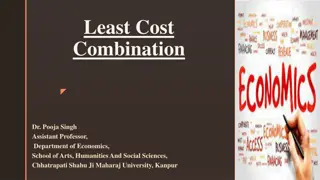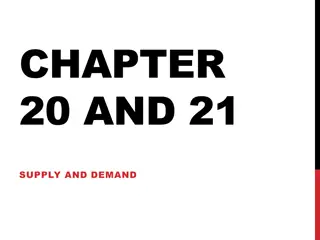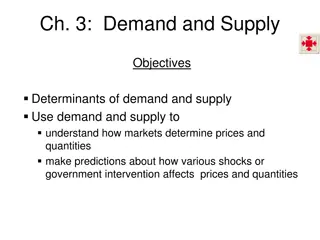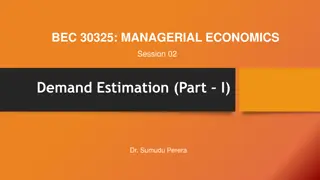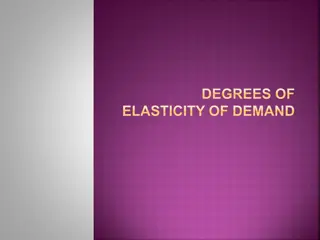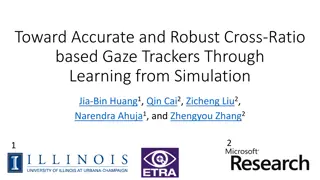Managerial Economics - Understanding Demand Estimation Fundamentals
Delve into the world of managerial economics with a focus on demand estimation. Explore concepts such as the law of demand, price elasticity, market demand vs. individual demand, and the demand curve. Learn how to analyze consumer behavior and predict market trends through quantitative analysis techniques. With Dr. Sumudu Perera as your guide, grasp the essential concepts of demand in the economic landscape.
Download Presentation

Please find below an Image/Link to download the presentation.
The content on the website is provided AS IS for your information and personal use only. It may not be sold, licensed, or shared on other websites without obtaining consent from the author.If you encounter any issues during the download, it is possible that the publisher has removed the file from their server.
You are allowed to download the files provided on this website for personal or commercial use, subject to the condition that they are used lawfully. All files are the property of their respective owners.
The content on the website is provided AS IS for your information and personal use only. It may not be sold, licensed, or shared on other websites without obtaining consent from the author.
E N D
Presentation Transcript
BEC 30325: MANAGERIAL ECONOMICS Session 02 DEMAND ESTIMATION (PART I) Dr. Sumudu Perera
Session Outline 2 Definition of Demand Law of Demand Price Elasticity of Demand Elasticity and Total Revenue Income Elasticity of Demand Cross Elasticity of Demand Demand Estimation Identification Problem Dr.Sumudu Perera 13/11/2024
3 DEMAND Quantity demanded is the amount of a good that buyers are willing and able to purchase. Law of Demand The law of demand states that, other things equal, the quantity demanded of a good falls when the price of the good rises. Dr.Sumudu Perera 13/11/2024
4 DEMAND continued The demand for a commodity arises from the consumers willingness and ability to purchase the commodity. Consumer demand theory postulates that the quantity demanded of a commodity is a function of or depends on the price of the commodity, the consumers income, the price of related commodities, and the tastes of the consumer. Dr.Sumudu Perera 13/11/2024
5 The Demand Curve The Demand Curve: The Relationship between Price and Quantity Demanded The demandcurve is a graph of the relationship between the price of a good and the quantity demanded. Demand Schedule The demand scheduleis a table that shows the relationship between the price of the good and the quantity demanded. Dr.Sumudu Perera 13/11/2024
Demand Schedule and Demand Curve for Ice- Cream Price of Ice-Cream Cone $3.00 2.50 1. A decrease in price... 2.00 1.50 1.00 0.50 Quantity of 0 1 2 3 4 5 6 7 8 9 10 11 12 Ice-Cream Cones 2. ... increases quantity of cones demanded.
7 Market Demand versus Individual Demand Market demand refers to the sum of all individual demands for a particular good or service. Graphically, individual demand curves are summed horizontally to obtain the market demand curve Dr.Sumudu Perera 13/11/2024
8 Elasticity A measure of the responsiveness of one variable to changes in another variable It is the percentage change in one variable that arises due to a given percentage change in another variable. The elasticity measure does not depend on the units in which we measure the variables.
9 Own Price Elasticity of Demand Own price elasticity: A measure of the responsiveness of the quantity demanded of a good to a change in the price of that good; Demand is elasticif the absolute value of the own price elasticity is greater than 1. Demand isinelasticif the absolute value of the own price elasticity is less than 1. Demand is unitary elastic if the absolute value of the own price elasticity is equal to 1.
10 Elasticity and Total Revenue If demand is elastic, an increase (decrease) in price will lead to a decrease (increase) in total revenue. If demand is inelastic, an increase (decrease) in price will lead to an increase (decrease) in total revenue. Total revenue is maximized at the point where demand is unitary elastic.
Price ED > 1 8 7 ED = 1 6 5 4 3 2 1 ED < 1 D Quantity 5 6 7 8 1 2 4 3 Revenue when the demand curve is unit-elastic Revenue when the demand curve is elastic Total Revenue Revenue when the demand curve is inelastic 40 30 20 10 TR Quantity 8 1 2 4 5 6 3 7
12 Factors Affecting the Own Price Elasticity Available substitutes The more substitutes available for the good, the more elastic the demand for it. A price increase leads consumers to substitute toward another product, thus reducing considerably the quantity demanded of the good. When there are few close substitutes, demand tends to be relatively inelastic. Time Demand tends to be more inelastic in the short term than in the long term. The more time consumers have to react to a price change, the more elastic the demand for the good. Time allows the consumer to seek out available substitutes Expenditure share Goods that comprise a relatively small share of consumers budgets tend to be more inelastic than goods for which consumers spend a sizable portion of their incomes.
13 Cross-Price Elasticity Cross-price elasticity: A measure of the responsiveness of the demand for a good to changes in the price of a related good; the percentage change in the quantity demanded of one good divided by the percentage change in the price of a related good. The cross-price elasticity is positive whenever goods are substitutes. The cross-price elasticity is negative whenever goods are complements.
14 Income Elasticity Income elasticity: A measure of the responsiveness of the demand for a good to changes in consumer income; the percentage change in quantity demanded divided by the percentage change in income. The income elasticity is positive whenever the good is a normal good. The income elasticity is negative whenever the good is an inferior good.
15 Advertising Elasticity The own advertising elasticity of demand for good X defines the percentage change in the consumption of X that results from a given percentage change in advertising spent on X.
16 Example 01: Mobile Phones The Demand of Axiaatar (QA), which is a well-known mobile phone, depends upon the price of an Axiaatar phone (PA), average daily income of people (Y) and price of Boppo phone (PB). Demand for QA is given by the equation below; QA = 60000 8PA + 3Y 2PB Assume that, PA is Rs.3000, Y is Rs.4000 and PB is Rs.2000. Find the value of quantity demanded of Axiaatar and the price elasticity of demand at that quantity. Calculate Income elasticity of demand and Cross price elasticity of demand. Interpret the above results and state how the interpretation would affect the decisions of Axiaatar s managers.
17 Demand Estimation Estimation attempts to quantify the links between the level of demand for a product and the variables which determine it. To use these important demand relationship in decision analysis, we need empirically to estimate the structural form and parameters of the demand function-Demand Estimation. Qdx= (P, I, Pc, Ps, T) Eg- The demand for hotel rooms depends upon: their price the price of bed and breakfast accommodation household incomes in visitors home countries natural events (the weather, foot-and-mouth disease)
18 Demand Estimation continued In general, we will seek the answer for the following qustions: How much will the revenue of the firm change after increasing the price of the commodity? How much will the quantity demanded of the commodity increase if consumers income increase What if the firms double its ads expenditure? What if the competitors lower their prices? Firms should know the answers for the above mentioned questions if they want to achieve the objective of maximizing thier value.
19 The Identification Problem The demand curve for a commodity is generally estimated from market data on the quantity purchased of the commodity at various price over time (i.e. Time-series data) or various consuming units at one point in time (i.e. Cross-sectional data). Simply joinning priced-quantity observations on a graph does not generate the demand curve for a commodity. The reason is that each priced-quantity observation is given by the intersection of a different and unobserved demand and supply curve of commodity. In other words, The difficulty of deriving the demand curve for a commodity from observed priced-quantity points that results from the intersection of different and unobserved demand and supply curves for the commodity is referred to as the identification problem.
20 The Identification Problem In the following demand curve, Observed price- quantity data points E1, E2, E3, and E4, result respectively from the intersection of unobserved demand and supply curves D1 and S1, D2 and S2, D3 and S3, and D4 and S4. Therefore, the dashed line connecting observed points E1, E2, E3, and E4 is not the demanded curve for the commodity. The derived a demand curve for the commodity, say, D2, we allow the supply to shift or to be different and correct, through regression analysis, for the forces that cause demand curve D2 to shift or to be different as can be seen at points E2, E'2. This is done by regression analysis.
